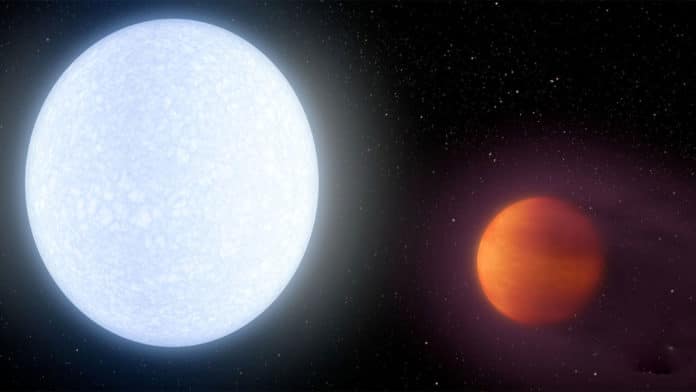Known as Ultra hot Jupiter, KELT-9b is an exoplanet that orbits the late B-type/early A-type star KELT-9. It is located about 670 light-years from Earth.
With a surface temperature of 7,800 degrees Fahrenheit (4,300 degrees Celsius) – hotter than some stars—this planet is the hottest found so far.
Recently, a group of astronomers using NASA’s Spitzer space telescope has discovered proof that the heat of the KELT-9b is an excessive amount of in any event, for molecules to remain intact. Molecules of hydrogen gas are likely ripped apart on the dayside of KELT-9b, unable to reform until their disjointed atoms flow around to the planet’s nightside.
Even though still very hot, the nightside’s slight cooling is sufficient to allow hydrogen gas molecules to reform—that is until they stream back to the dayside, where they’re torn apart all over again.
Megan Mansfield, a graduate student at the University of Chicago, said, “This kind of planet is so extreme in temperature, it is a bit separate from a lot of other exoplanets. There are some other hot Jupiters and ultra-hot Jupiters that are not quite as hot but still warm enough that this effect should be taking place.”
To study the KELT-9b, scientists used the Spitzer space telescope to parse temperature profiles from this infernal giant. Spitzer, which makes observations in infrared light, can quantify subtle varieties in heat. Repeated over numerous hours, these perceptions allow Spitzer to capture changes in the atmosphere as the planet presents itself in phases while orbiting the star. Various parts of the planet roll into view as it revolves around its star.
The observations enabled scientists to get a look at the distinction between KELT-9b’s dayside and its “night.” For this situation, the planet orbits its star so firmly that a “year”— once around the star —takes just 1 1/2 days. That implies the planet is tidally locked, displaying one face to its star forever (as our Moon shows only one look to Earth). On the most distant side of KELT-9b, nighttime lasts forever.
But gases and heat flow from one side to the other. A big question for researchers trying to understand exoplanet atmospheres is how radiation and flow balance each other out.
Mansfield said, “If you don’t account for hydrogen dissociation, you get high-speed winds of [37 miles or] 60 kilometers per second. That’s probably not likely.”
The findings are published in Astrophysical Journal Letters.
